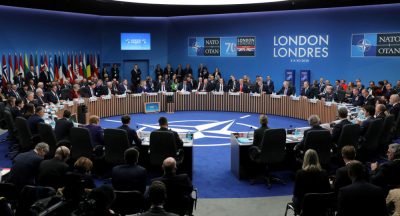70th NATO Anniversary Shows Alliance Is More Divided than Ever

When U.S. President Donald Trump cancels a NATO press conference because the other NATO leaders are mocking him, you know that something is wrong. At the historic NATO Summit to commemorate 70 years of NATO earlier this week, the Alliance remembers how “brain dead”, as described by French President Emmanuel Macron, that the organization has become. This disastrous summit will be remembered in history as the beginning of the end for NATO as there was plenty of hostilities and controversies that were not even close to being resolved.
Theoretically the great loser of the summit was Turkey, with its magnificent and failed bluff. Turkish President Recep Tayyip Erdoğan‘s threat to block the Alliance’s decision to “protect” the Baltic states and Poland “from possible Russian aggression” if NATO did not recognize the Kurdish People’s Protection Units (YPG) in Syria as a terrorist organization had resulted to nothing. The fact that NATO members have even refused to discuss the YPG, with the exception of British Prime Minister Boris Johnson, as they carry out their provocative action to send forces to the Baltic is tantamount to a massive personal disappointment for Erdoğan.
But those who hastened to talk about Turkey’s international isolation have not noticed a slight laughter from the American president that changed everything. During a stormy joint press conference with his French counterpart, Trump appeared to offer an impressive friendly gesture to Erdogan, even though the Turkish leader bought the Russian S-400 missiles that received the scorn of Trump. In a complete reversal of roles, Macron wondered how a NATO member state could supply Russian missile defense systems while Trump just laughed it off. Trump has claimed incorrectly that he is not solely responsible for the Turkish purchase of the S-400 as his predecessor Barack Obama refused to sell the Patriot systems to Turkey.
Trump’s friendly attitude towards Erdoğan seems to once again disprove analysts who have predicted a complete split in U.S.-Turkish relations. It is now clear that the temporary withdrawal of U.S. forces from North Syria, which gave the “green light” for the Turkish invasion, is expressing a new page in Trump’s relations with the Turkish President.
However, one of the most interesting clashes between NATO leaders has provided material to journalists who covered the Summit, as there are clear and unprecedented gaps between Europe and the U.S. In a joint statement, NATO leaders appeared to agree that Russia’s supposed offensive actions pose a threat to Euro-Atlantic security and that China’s growing influence supposedly poses new challenges for the Alliance. However, both of these issues actually had dividing opinions, rather than united.
“The greatest danger,” said Emmanuel Macron, “is not a Russian invasion of the Baltic states, but terrorism, that is, the danger we face from the South and to which NATO has no answer,” adding “Is it the purpose of the Atlantic Alliance to identify one or the other [Russia or China] as our enemies?”
He had recently stated that he did not see China as a major threat to member countries of the Alliance. The French president may have seemed like a lonely knight within NATO, but in reality, he was still expressing the ideas of several European countries that were reacting silently to Washington’s attempt to drag Europe into an open confrontation with Moscow and Beijing. Countries such as Italy and Greece, which have opened their doors to Chinese investment in infrastructure such as 5G mobile networks and port developments, have no desire to see NATO become an opposition force to the Beijing.
But that is exactly what the Secretary General of the Alliance, Jens Stoltenberg, wants to do on behalf of Washington. In recent statements, he made clear that not only Beijing’s increased defense spending is a concern, but even China’s foremost in economic and technological development.
Stoltenberg showed concern and in his own words said China is a leader in the development of new technologies, from 5G networks to facial recognition technology and from quantum computers to large data processing.
Stoltenberg said the alliance needed to start taking “into account that China is coming closer to us.”
“We see them in the Arctic, we see them in Africa, we see them investing heavily in European infrastructure and of course investing in cyberspace,” Stoltenberg said of China, adding that this was not “about moving NATO into the South China Sea.”
If the NATO Anniversary Summit reveals anything, it is that Washington wants to turn the Alliance into a weapon against Beijing.
“A challenge from China could be just the thing to pull NATO together” said a CNN analyst. Europe, however, is unlikely to fall into U.S. fearmongering about Russia and China. And if it does not, then this just leads to the question about what the purpose of NATO is.
*
Note to readers: please click the share buttons above or below. Forward this article to your email lists. Crosspost on your blog site, internet forums. etc.
This article was originally published on InfoBrics.
Paul Antonopoulos is a Research Fellow at the Center for Syncretic Studies.
Featured image is from InfoBrics

